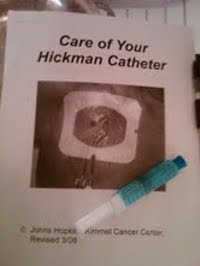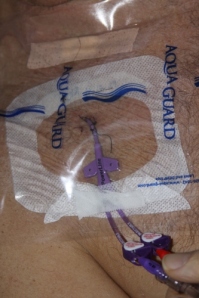
Johns Hopkins Instructions for taking care of a Hickman Line and a Heparin I.V. flush syringe.
Because the line is sewn directly into a vein, risk of infection is always a concern. Consequently, the catheter is always covered by a Tegaderm dressing. The dressing provides for a snug fit over the site and enables you to see through the dressing to check the site for infection. It is changed weekly and the procedure is quite a mini production. Masks and gloves are worn and there is even another set of sanitized gloves that must be put on after the old dressing is removed. My wife has been trained to change the dressing and we have kits at home with all the items needed. To take a shower I have to cover the dressing with yet another dressing, called an AquaGuard. The AquaGuard is supposed to prevent the site from getting wet. Don’t tell my nurses but the site still usually gets wet.
If you have not figured it out by now, we cancer patients are very needy and, unfortunately, require much care and attention. Often, it seems that I have it pretty easy compared to all of the work that others, especially my wife, have to do on my behalf.
The following is an explanation of Hickman Lines from Wikipedia:
“A Hickman line is an intravenous catheter most often used for the administration of chemotherapy or other medications, as well as for the withdrawal of blood for analysis. Some types of Hickman lines are used mainly for the purpose of apheresis or dialysis. Hickman lines may remain in place for extended periods and are used when long-term intravenous access is needed.
The insertion of a Hickman line is usually done under sedation or a general anesthetic by a radiologist or surgeon. It involves two incisions, one at the jugular vein or another nearby vein or groove, and one on the chest wall. At the former incision site (known as the “entrance” site), a tunnel is created from there through to the latter incision site (known as the “exit” site), and the catheter is pushed through this tunnel until it “exits” the latter incision site.” [Read more]



